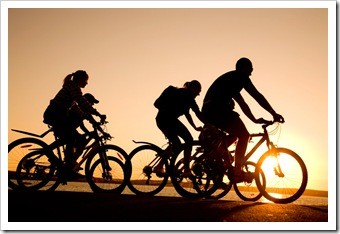
Or is it? However you choose to scoot around on your two wheels – on-road, off-road, for fun or in competition – the bicycle you use to do it has to be tailored not just to those needs, but also to your body, physicality, and health considerations. You wouldn’t enter a road-race on a kid’s plastic trike, and neither should you ignore the finer points when matching your bike to your body.
Your bike needs to fit your body. When it does, you will feel the difference because you will ride more comfortably, more powerfully, covering more ground faster, with less effort, and with less risk of injury.
In a nutshell, there are five considerations when matching yourself to a bike:
1. Frame size
2. Seat height
3. Seat position
4. Seat tilt
5. Handlebar position
Frame Size
Get this wrong and you’ll look like you just stole the bike from someone else. This is the most important measurement to properly size up because the frame is the one thing that cannot be adjusted – unless you’re handy with a hacksaw and welding torch. Frame size is not always down to a person’s overall height; it is the leg length that matters. You should be able to straddle the bike frame (not the seat) and be able to plant both feet flat on the floor without squeaking from contact made higher up. For guys with the horizontal top-tube design, this is important if you are ever shifted forward off the seat unexpectedly. If your feet don’t hit the floor before your crotch hits the top tube … squeak.
- For a road or hybrid bike, the crotch/tube gap should be an inch or two.
- For a mountain bike, it should be about four inches given the higher likelihood of an unplanned dismount on rough terrain.
Seat Height
Setting the seat too high or too low can lead to pain and injury to the back and knees, and an inefficient revolution of each pedal stroke. When the pedal is at its lowest point with the ball of your foot on the pedal, your knee should be slightly bent. Make this seat adjustment wearing the shoes you will normally wear when riding.
Seat Position
You need to be sitting on your bike to check the seat position, with the aid of something or someone to hold on to so both feet can be on the pedals. Rotate the pedals until they are at the 3 o’clock and 9 o’clock positions. With the ball of your foot on the pedal, your forward knee should be directly over the axle of that pedal. If this is not the case, make the necessary adjustment by sliding the seat forward or backward.
Seat Tilt
Your seat should ideally be level, which can be checked with a spirit level if you’re really bored. Make sure you’re not on a hill when you do this – obviously. If your seat tips too much one way or the other, there will be pressure on your arms, shoulders, and lower back. Choose the seat design accordingly, bearing in mind the padding and the length of your average bike ride.
Handlebar Position
How you position the handlebars will be determined largely by the type of bike you have. Bullhorn handlebars on a racer won’t really work aerodynamically. Your shoulder, neck, and back are all affected by your handlebar position and design.
Always Wear a Helmet!
It’s no use having very relaxed muscles if your head breaks open. As your muscles go into rigor after death, even the ME who deals with your body will have no idea how relaxed you were just before the impact. The National Highway Safety Traffic Administration reports that a properly fitted bicycle helmet reduces the risk of head injury by 85%, and brain injury by 88%. You can ensure your helmet fits correctly by taking note of the following:
- Your helmet should be level on the head, while protecting the forehead.
- Your ears should just fit inside the Y shape of the side straps.
- The chin strap should be snug enough that if you open your mouth wide, it pulls the helmet down slightly.
- If you can move your helmet back on your head more than an inch by pushing on the front, it is not correctly fitted.
- If the helmet dislodges when you give your head a shake, you can be sure worse will happen in an accident.
- Sounds obvious, but don’t wear another hat under the helmet – you’re not Eminem.
- Helmets should conform to the relevant national/international standards applicable to the country where you live, and have the appropriate stickers to prove it. World War II helmets aren’t a good substitute and you will quickly become known locally as “that loon on the bike”.
For Your Health,
Dr. Mark Hardwick and Dr. Mitchell Jacobs
